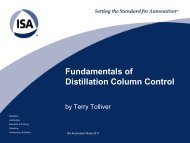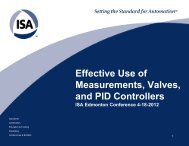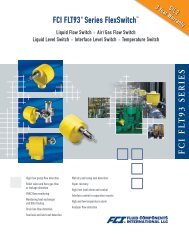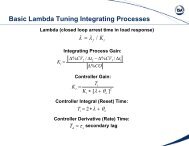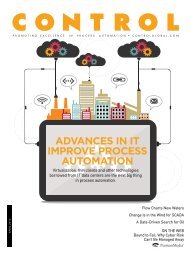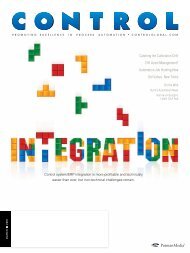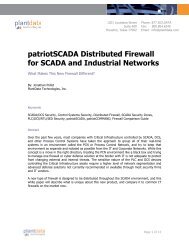April 2011 - Control Global
April 2011 - Control Global
April 2011 - Control Global
Create successful ePaper yourself
Turn your PDF publications into a flip-book with our unique Google optimized e-Paper software.
F L O W<br />
Flowmeter Boosts<br />
Solvent Recovery<br />
Improved measurement accuracy delivers<br />
better control and savings.<br />
BY LARELL PALMER AND ERIK SCHROEPPEL<br />
The Eli Lilly and Co. (www.lilly.com) processing plant in Clinton,<br />
Ind., uses a fermentation-based process to produce animal<br />
health products. Solvent is recovered from the fermentation medium<br />
and reused in the production process, providing environmental<br />
benefits as well as raw material cost savings.<br />
Three recovery columns distill the fermentation medium<br />
to recover the 1% to 2% of solvent it contains. Vaporized<br />
solvent is condensed to provide a very pure liquid for recycling.<br />
Maintaining high efficiency and speed of separation<br />
requires precise control of the temperatures, pressures and<br />
flows of components along the column.<br />
The separators also are very important to the overall process<br />
mass balance. Inefficient operation can lead to energy<br />
waste, output-product-purity problems and poor yield.<br />
The solvent recovery process is continuous and runs yearround.<br />
The flow rate into each column is roughly 300 liters/<br />
minute. This amounts to 125 million liters/<br />
year per column, which requires extracting<br />
RAISING THE CORIOLIS FLAG<br />
Figure 1. Eli Lilly & Co.’s plant in Clinton, Ind., installed the<br />
first Coriolis flowmeter in its solvent recovery application<br />
in the “flag” orientation on a vertical section of pipe on<br />
the feed line of Column 1 during a routine maintenance<br />
shutdown.<br />
around 6 million liters/year of solvent from each column. The<br />
uptime of each column has been around 80% due to maintenance,<br />
upsets and planned downtime.<br />
Drivers for Change<br />
Companies like Lilly now expect a lot more from process<br />
control and instrumentation than in the past. We’re continually<br />
looking to minimize waste, maximize output and optimize<br />
efficiency throughout the plant. There’s much more<br />
focus on the accuracy and reliability of measurements. With<br />
the solvent recovery columns, we needed to upgrade the instruments<br />
to provide greater accuracy and reliability.<br />
The existing differential pressure/orifice flowmeters,<br />
which measure feed, overhead and bottom flows of the separator<br />
columns, were around 25 years old and had reached<br />
the end of their useful lives. In fact, we actually had stopped<br />
performing time-consuming maintenance on these devices.<br />
When first installed, they had provided adequate flow measurements<br />
that even now would be good enough for inventory<br />
management. However, they no longer were giving the<br />
accuracy or reliability required for the recovery process.<br />
As a result, much of the operation of the columns became<br />
manual. Columns were put in recycle mode due to more frequent<br />
process upsets. Lost uptime was estimated to cost an<br />
average of $3,000 per upset.<br />
Once or twice a month, the feed flow measurements were<br />
so poor that we experienced excursions outside of the control<br />
limits. These excursions could be very costly, requiring<br />
isolation of the waste streams and further testing/treatment,<br />
as well as disruption of other plant processes. We estimated<br />
the cost to be as high as $50,000 per upset.<br />
Photo by Christopher Meyer, Rosemount<br />
44 www.controlglobal.com A P R I L / 2 0 1 1



